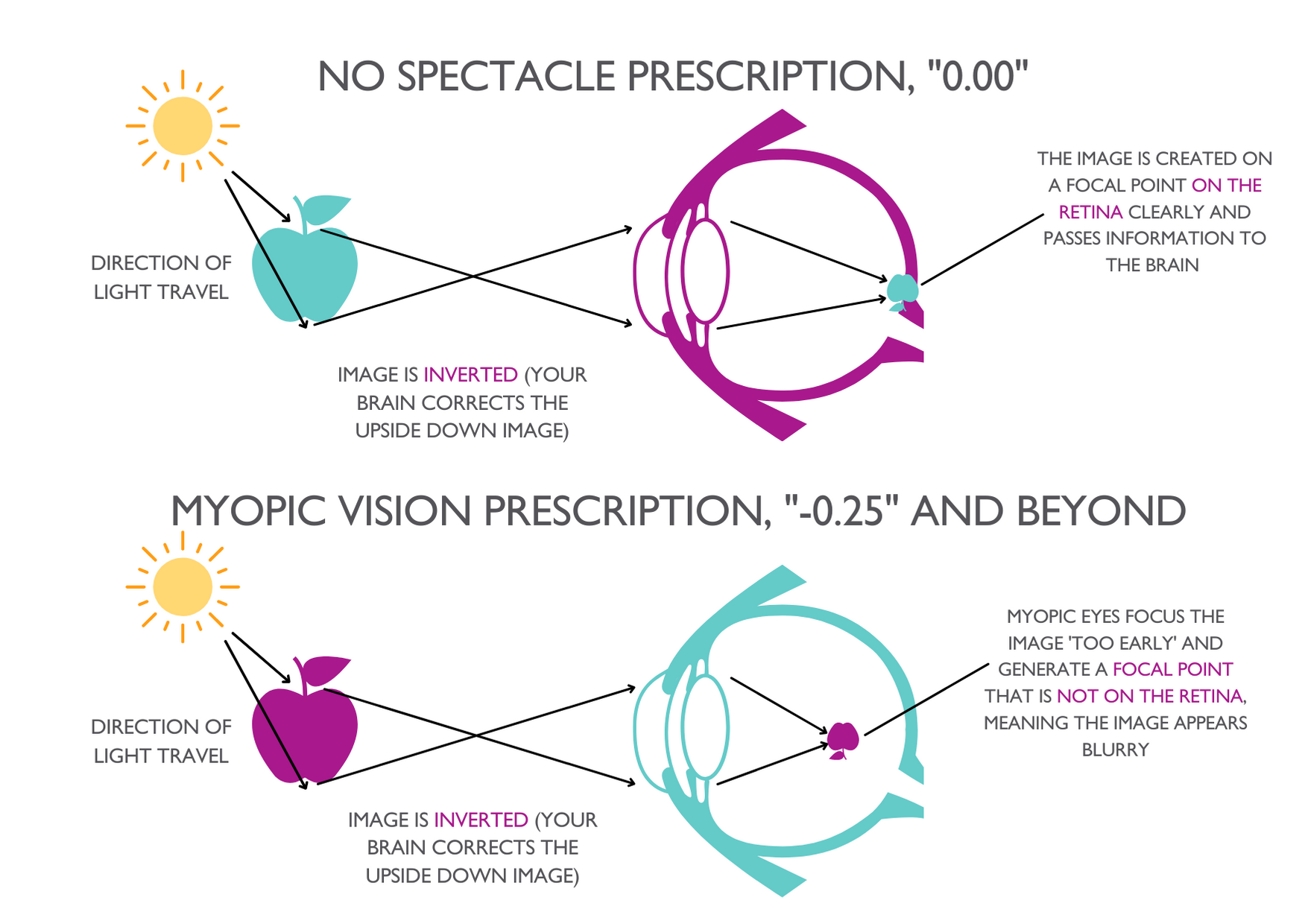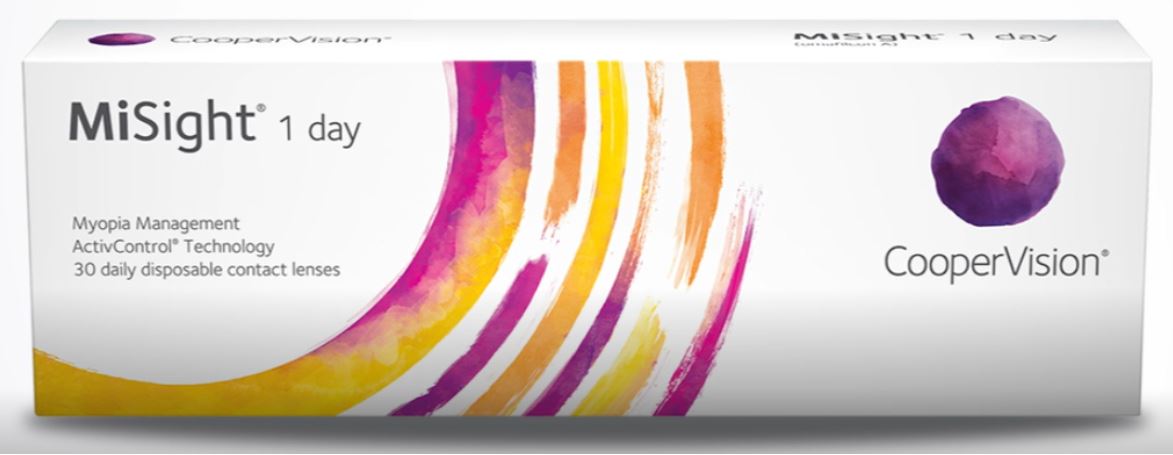Managing Myopia in Children
What is myopia?
Myopia is the clinical term for shortsightedness, it means that people see distant objects as blurry. 1 in 3 people in the UK [1] are affected by myopia and it is estimated that half the world’s population will be myopic by 2050.
Myopia can develop at any age, but is most concerning when it starts in young children. This is because the eye grows throughout childhood which can lead to rapidly progressing myopia. The earlier myopia starts, the higher the myopia can potentially become which increases risk to eye health. “0.00”, or “Plano” on your prescription means there is no adjustment needed by use of lenses to improve your vision. Myopia is always measured in negative numbers, measured in -0.25 increments and below. All myopic prescriptions are worth managing in children, your Optometrist will advise you on the best care for the different ranges of shortsightedness:
- Mild myopia: -0.25 to -3.00
- Moderate myopia: -3.25 to -5.00 or -6.00
- High myopia: greater than -5.00 or -6.00

In contrast, hyperopia or ‘longsightedness’ (the opposite of myopia) is always a positive integer, ranging from +0.25, upwards. People with hyperopia see objects closest to them as blurry and unlike myopic patients, will be able to see distant objects with more clarity.
What are the symptoms of myopia? What should you look out for?
In yourself, you may notice that distant objects appear blurry. This could be a street sign while driving or squinting to watch the TV. Our Qualified Dispensing Opticians are on hand to advise which glasses can help correct your vision for these different scenarios.
Anyone can begin to form myopia and because kids don’t often realise that their eyesight isn’t “normal”, there are few key things for us grown-ups to look out for. In babies, toddlers and children, you may notice that they regularly rub their eyes, sit too close to the TV, struggle to see the whiteboard at school and complain of headaches and/or eye strain.
In some cases, there are no symptoms at all and that’s why regular check ups at your local optician are so important. We encourage parents to bring children in for eye examinations from a young age. Ideally, children should have their first eye test no later than age 3 or 4.
Myopia tends to progress while we grow, so for the majority of myopic children, the changes in prescription naturally slows down in our late teens to early twenties. Myopia management needs to be considered part of the plan for this time period.
Adults do not develop myopia in quite the same way as children, so myopia management is not needed for adults.
If you are concerned about your own or your child’s eyesight, we recommend you visit us for an eye examination as soon as possible. Ultra-wide field and 3D Retinal Photography comes as standard as part of the Leightons Ultimate Eye Examination, where we take a digital image of the back of the eye and are able to offer you the best possible advice for your care.
What causes myopia?
Myopia can be a result of family history and lifestyle, or a combination of both. It usually begins in childhood and is more common in children who have a myopic parent, although sometimes there is no family history. Other influencing factors are the environment and spending increased amounts of time doing near tasks, including using smartphones, tablets and computers.
There is increasing evidence to suggest that extended periods of time doing high concentration, close vision tasks, including the use of smartphones, tablets and computers, can increase myopic symptoms [2].
Ensuring your children regularly spend time playing outside and using computer screens safely may help to reduce their risk of becoming shortsighted. This can include the 20 20 20 rule (looking away for 20 seconds every 20 minutes at something 20 feet away from you) and making sure there is always adequate lighting, especially when doing high concentration tasks and close work such as reading and writing.
What are the risk factors, associated conditions and progression of myopia?
The onset of myopia at an early age, guarantees a need for lifelong eyecare. Rising levels of myopia are connected with a number of serious eye problems and not just the need for glasses throughout life.
Unfortunately, myopia can also lead to eye conditions and complications:
- glaucoma – increased pressure inside the eyes
- retinal detachment – where the retina pulls away from the back surface of the eye
- myopic maculopathy - where vision fades away and can completely degenerate from the centre of your vision
At Leightons, we recommend an examination which includes retinal imaging for adults and children alike, allowing your optometrist to see a detailed picture of the back of your eye and check for early signs of conditions like glaucoma, retinal detachments and tears.
How can Leightons help?
Although there is currently no cure for myopia, regular eye tests monitor your vision and overall health and, based on the results, allow us to make recommendations for the best eyecare for you and your family. Our team has extensive experience in myopia management and can advise whether your child is suitable to be treated. Every child is different and each treatment is tailored to suit both the child and the type of correction that needs to be managed.
There are a number of products available to manage myopia. We have included a few options, below, for you to explore. Your local eyecare team will advise on the best products for your child.
Soft Contact Lenses
There are a number of different soft contact lens options for myopia management. One of the most frequently recommended is MiSight® by Coopervision. These contact lenses are soft daily disposable lenses that are specially designed to reduce the progression of myopia (or shortsightedness) in children. Lenses are worn through the day as a standard one day soft lens, for a minimum of six days a week.
Studies have suggested that the MiSight® one day disposable lens has been proven to slow down myopia by up to 59% [3]. This means that if fitted early enough with this lens, most children will end up with less than half the strength of myopia than if fitted with a conventional contact lens or spectacles.
Soft contact lenses including MiSight® for myopia management are available in all Leightons Opticians & Hearing Care practices.

ORTHOKERATOLOGY
Orthokeratology, or Ortho-K contact lenses are worn overnight to gently reshape the surface of the front of the eye (cornea), consequently reducing the progression of myopia. They are removed in the morning to give crisp, glasses and contact lens free vision all day which can be especially useful for those in active sports, particularly contact and water sports.
Orthokeratology treatment is available in the following Leightons Opticians & Hearing Care practices:
- Chandlers Ford
- Cobham
- Epsom
- Farnham
- Hempstead Valley
- Lewes (Spectrum Eyecare)
- Marlow (Leightons Insight)
- Poole (Leightons & Tempany)
- Southampton
- St Albans
- Thatcham
MiYOSMART lenses by HOYA
Corrective contact lenses and orthokeratology isn’t the only way to go! At Leightons, we are proud to offer MiYOSMART lenses from HOYA. This ground-breaking technology works to help children manage and slow the progression of myopia.
MiYOSMART is an innovative spectacle lens for myopia management. Based on a two-year clinical trial result, MiYOSMART is proven to curb myopia progression in children on average by 60% [4] with its award-winning D.I.M.S. (Defocus Incorporated Multiple Segments) technology.
We know that kids will be kids, these HOYA lenses are made with light, thin and impact-resistant material, safest for even the most active of kids, and have a UV coating to protect eyes from blue light (from screens to low level sunlight).
Our team will be able to guide you on how best to use these lenses with your child: spending more time outside, wearing them as much as possible (especially for high concentration tasks such as homework) and getting regular check ups with us.

What happens if you don’t wear your corrective lenses or contacts all of the time?
Even with myopia management, your child may need a stronger prescription as they continue to grow so we recommend regular visits to your optician and keeping up to date with their latest prescription. Always take your Optometrist’s advice when it comes to corrective lenses as they will be able to offer you bespoke advice on a case by case basis. OrthoK lenses must be worn every night and myopia managing contact lenses (or glasses) must be worn everyday in order to achieve the best results. Talk to your optometrist to determine whether contact lenses, glasses, or perhaps a mixture of the two options is best for your child.
Begin your Myopia Management Journey, today
If you’re interested in discovering more about myopia management, have any questions or would like to book a consultation with your child, call our Dedicated Patient Support team on 0800 40 20 20 or book an appointment online.
We recommend our Ultimate Eye Examination which includes ultra-wide field and 3D retinal layer imaging and a full back of eye health assessment to examine any myopic symptoms and help advise you on the best care for your little one.
[1] NHS: https://www.nhs.uk/conditions/short-sightedness/
[2] Relation between Near Work and Myopia Progression in Student Population. Mater Sociomed, 2014: https://misuse.ncbi.nlm.nih.gov/error/abuse.shtml
[3] Clinical trial, A 3-year Randomized Clinical Trial of MiSight Lenses for Myopia Control, Chamberlain, 2019
[4] Myopia progression (SER) by 59% and axial elongation (AL) decreased by 60% compared with those wearing SV lenses.

